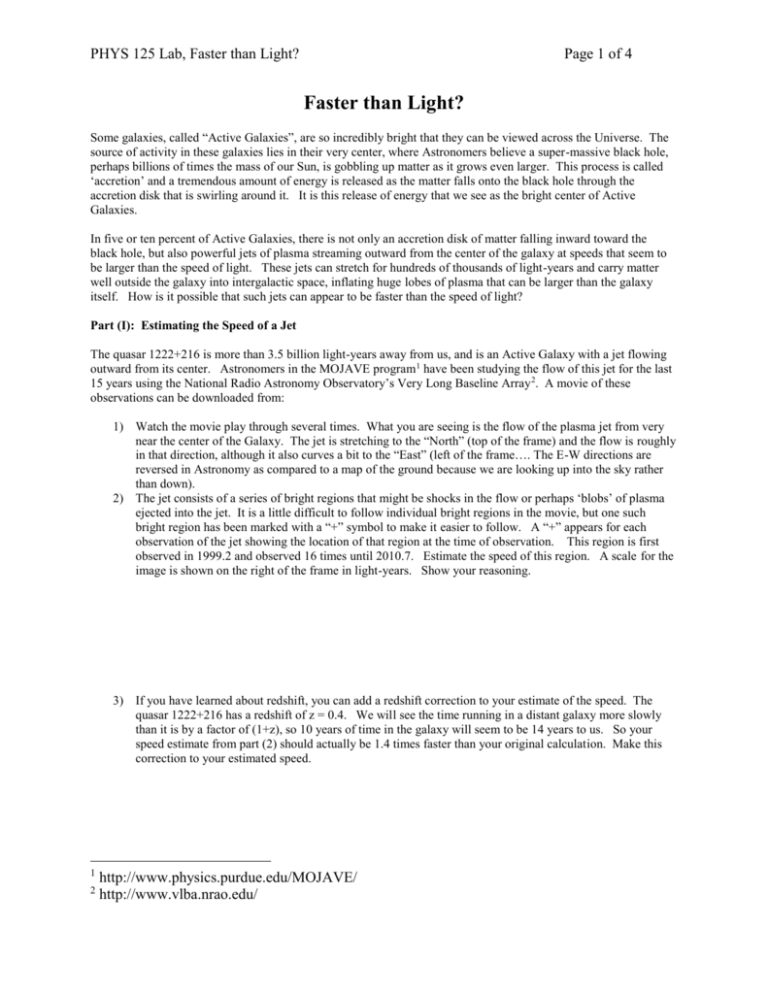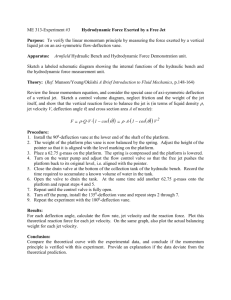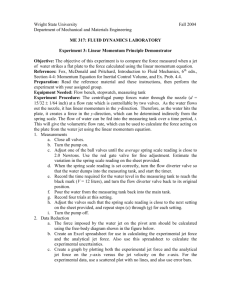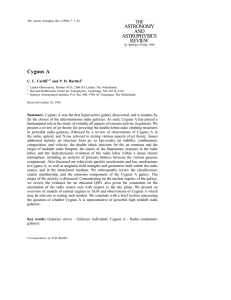Faster-than-Light - Personal Pages
advertisement

PHYS 125 Lab, Faster than Light? Page 1 of 4 Faster than Light? Some galaxies, called “Active Galaxies”, are so incredibly bright that they can be viewed across the Universe. The source of activity in these galaxies lies in their very center, where Astronomers believe a super-massive black hole, perhaps billions of times the mass of our Sun, is gobbling up matter as it grows even larger. This process is called ‘accretion’ and a tremendous amount of energy is released as the matter falls onto the black hole through the accretion disk that is swirling around it. It is this release of energy that we see as the bright center of Active Galaxies. In five or ten percent of Active Galaxies, there is not only an accretion disk of matter falling inward toward the black hole, but also powerful jets of plasma streaming outward from the center of the galaxy at speeds that seem to be larger than the speed of light. These jets can stretch for hundreds of thousands of light-years and carry matter well outside the galaxy into intergalactic space, inflating huge lobes of plasma that can be larger than the galaxy itself. How is it possible that such jets can appear to be faster than the speed of light? Part (I): Estimating the Speed of a Jet The quasar 1222+216 is more than 3.5 billion light-years away from us, and is an Active Galaxy with a jet flowing outward from its center. Astronomers in the MOJAVE program 1 have been studying the flow of this jet for the last 15 years using the National Radio Astronomy Observatory’s Very Long Baseline Array 2. A movie of these observations can be downloaded from: 1) Watch the movie play through several times. What you are seeing is the flow of the plasma jet from very near the center of the Galaxy. The jet is stretching to the “North” (top of the frame) and the flow is roughly in that direction, although it also curves a bit to the “East” (left of the frame…. The E-W directions are reversed in Astronomy as compared to a map of the ground because we are looking up into the sky rather than down). 2) The jet consists of a series of bright regions that might be shocks in the flow or perhaps ‘blobs’ of plasma ejected into the jet. It is a little difficult to follow individual bright regions in the movie, but one such bright region has been marked with a “+” symbol to make it easier to follow. A “+” appears for each observation of the jet showing the location of that region at the time of observation. This region is first observed in 1999.2 and observed 16 times until 2010.7. Estimate the speed of this region. A scale for the image is shown on the right of the frame in light-years. Show your reasoning. 3) If you have learned about redshift, you can add a redshift correction to your estimate of the speed. The quasar 1222+216 has a redshift of z = 0.4. We will see the time running in a distant galaxy more slowly than it is by a factor of (1+z), so 10 years of time in the galaxy will seem to be 14 years to us. So your speed estimate from part (2) should actually be 1.4 times faster than your original calculation. Make this correction to your estimated speed. 1 2 http://www.physics.purdue.edu/MOJAVE/ http://www.vlba.nrao.edu/ PHYS 125 Lab, Faster than Light? Page 2 of 4 Part (II): Explaining the Paradox We learned in our study of special relativity that it is impossible to travel faster than the speed of light; however, your speed estimates on the previous page are many times the speed of light. What might explain this? A simulation of apparent faster-than-light motion, called “superluminal motion”, is included with this activity. You may view a quicktime movie of the simulation called ‘super.mov’. Play the movie several times and watch closely to see what is happening. A jet component is moving down the jet at 95% of the speed of light (speed = 0.95c), and the jet is pointed at a small angle toward the direction of Earth. As the component is moving, it is giving off light (shown as blue spheres) which travel to Earth and are observed. A pair of graphs on the right show the motion of the jet component along the jet in real space and from the point of view of Earth as seen by the light arriving at Earth. 1) Based on your observations write a qualitative explanation, several sentences long, for why the jet component appears to move faster than it really is. If you are stuck, you may wish to go ahead to the next simulation and see if that provides some help in understanding. 2) View the simulation in the case where the jet is moving away from Earth…. view super_away.mov. What happens to the apparent speed of the jet component? Does this fit with your explanation for the previous simulation? Explain. PHYS 125 Lab, Faster than Light? Page 3 of 4 3) Based on your qualitative explanation on the previous page, try to derive the quantitative formula that gives the apparent speed of the jet… NOTE: = angle between jet direction and line of sight to Earth. No time dilation or Lorentz frame changes are required for this derivation… just geometry and careful thinking. v app x app v sin t app 1 v cos c or app sin 1 cos Do this calculation on a blank piece of paper (it may take several tries) and attach it to this activity. As a hint, you may wish to focus on showing that the apparent time interval, t app t(1 cos ) . 4) Try these formula out for the simulation movies: v = 0.95 c and = 18 degrees for the original movie (in the “away” movie, the angle is changed to be 162 degrees). Do the speeds match those given in the graphs of the simulation? 5) Plot this formula in an Excel spreadsheet. Plot apparent speed (in units of speed of light) against angle. Plot several curves, one for an intrinsic speed of v = 0.95c, 0.98c, 0.99c, 0.995c etc… Describe the graphs that you see. Can you use these graphs to estimate a minimum intrinsic speed for the jet in the quasar 1222+216? Explain your estimate. PHYS 125 Lab, Faster than Light? Page 4 of 4 Part (III): Connection with the Doppler Effect 1) No time dilation or Lorentz transformations were required for the derivation in the part above. Why was that the case? Is this a ‘special relativistic’ effect at all? The same kind of reasoning can explain why a train whistle, or a car horn, sounds higher pitched as the vehicle moves toward you and lower pitched as it moves away. Think about this and write a qualitative explanation, based on the same physical principles used here, to explain why this happens to car horns and train whistles. You may wish to look up the Doppler effect in your textbook for inspiration.









